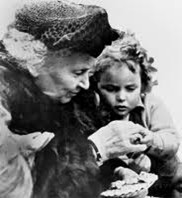Maria Montessori
Children are human beings to whom respect is due, superior to us by reason of their innocence and of the greater possibilities of their future.

Maria Montessori, founder of the Montessori Philosophy, was born in 1870 and became Italy’s first woman medical doctor in 1896. Her particular interest was in children, which led her to study the works of physicians such as Jean-Marc Gaspard Itard, who worked at a Paris institution for deaf-mutes.
Dr. Montessori believed that observation was just as important in education as in treating the sick and that the mind developed through the actions of the senses. She pursued this belief through experiments with the mentally defective.
In 1900 Dr. Montessori became the director of a practice demonstration school established by the National League for Retarded Children. With 22 students, she now had her first chance to use Itard’s sensory teaching materials and modify them for her use. She designed and had manufactured a set of teaching materials based on his principles.
She systematically observed the children and their individual needs and worked out the best means to teach them. Those children who had previously been abandoned as incapable of learning to function productively began showing the ability to care for themselves. When these mentally disabled children passed exams on a level with ‘normal’ children, she began questioning the calibre of ‘normal’ education.
Dr. Montessori was so successful in her work with these children that she was now regarded as an educator rather than a physician. Realizing that excellent results could be obtained by applying these theories to the teaching of normal children, she left her work with the retarded.
 In January 1907, Dr. Montessori opened the first Casa di Bambini in the San Lorenzo slums of Rome. When the building was offered to Dr. Montessori, the owners hoped that she would provide a place where the children of working mothers could be kept off the streets, thereby reducing vandalism. Ultimately, the children were not only off the streets; they became eager students.
In January 1907, Dr. Montessori opened the first Casa di Bambini in the San Lorenzo slums of Rome. When the building was offered to Dr. Montessori, the owners hoped that she would provide a place where the children of working mothers could be kept off the streets, thereby reducing vandalism. Ultimately, the children were not only off the streets; they became eager students.
The learning materials were designed to be self-correcting, and the children thrived on the activity involved with learning. In observing these children, Dr. Montessori noticed that after doing a particular activity, the children continued working with it repeatedly rather than putting it away. They seemed to work for the sake of working, not for reward. She also introduced reading and writing to these children of illiterate parents. This project marked a turning point in Maria Montessori’s career and life and would soon cast her as the world’s foremost female educator.
By 1913, there were nearly 100 Montessori schools in America. Currently, the United States has three thousand private Montessori Schools and several educational programs implementing or supplementing Montessori in their classrooms. The Montessori Method has proven adaptable and beneficial to all socioeconomic levels and specialties within the educational systems.
In 1976, the first Montessori School was opened in South Africa by Mrs. Strilli Oppenheimer. Today, there are numerous Montessori schools throughout South Africa and in Botswana, Swaziland, Zimbabwe, and Namibia.

